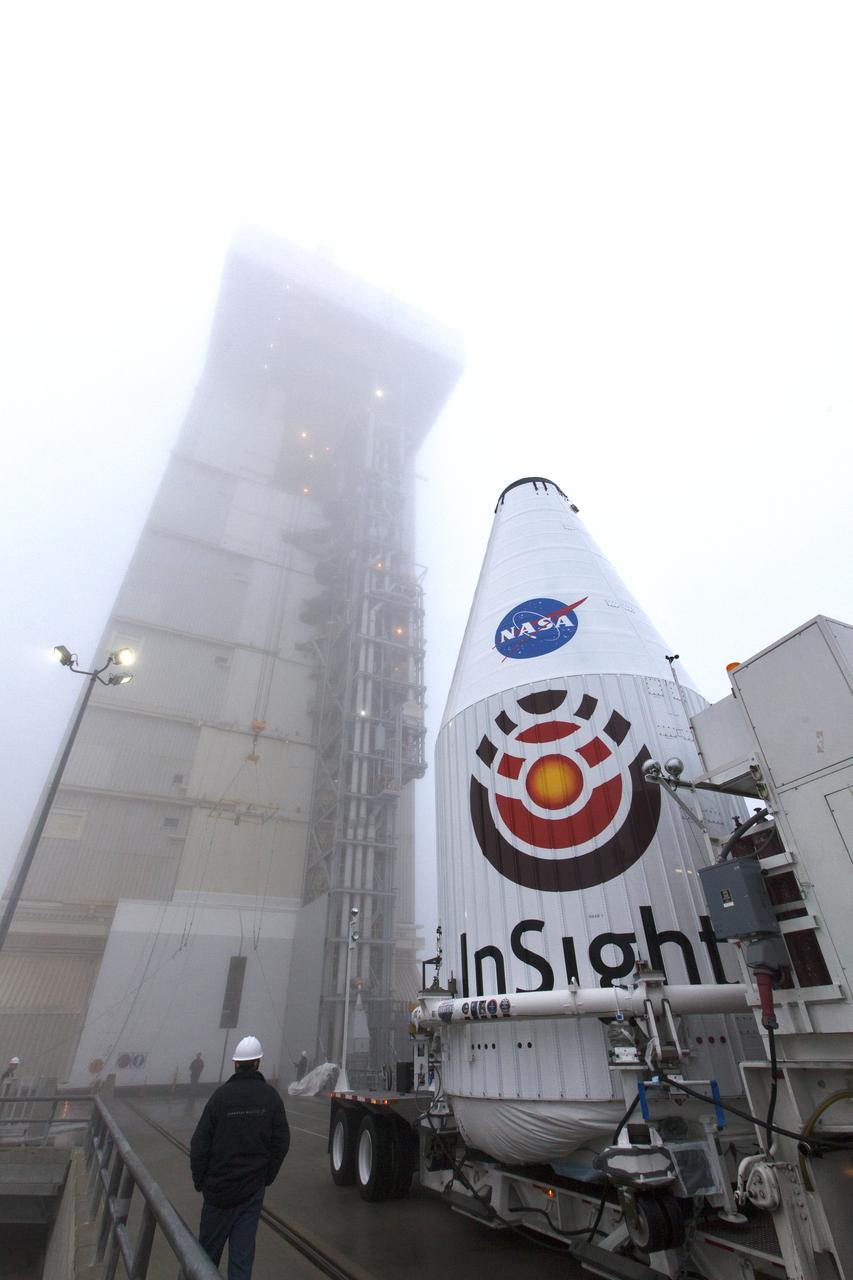NASA sets sights on May 5 launch of InSight Mars mission
2018-04-30
NASA’s next mission to Mars, Interior Exploration using Seismic Investigations, Geodesy and Heat Transport (InSight), is scheduled to launch May 5 on a first-ever mission to study the heart of Mars. Coverage of prelaunch and launch activities begins May 3 on NASA TV and the agency’s website.
InSight, the first planetary mission to take off from the West Coast, is targeted to launch at 6:05 a.m. CDT (4:05 a.m. PDT) from Space Launch Complex-3 at Vandenberg Air Force Base in California aboard a United Launch Alliance (ULA) Atlas V rocket.
Launching on the same rocket is a separate NASA technology experiment known as Mars Cube One (MarCO). MarCO consists of two mini-spacecraft and will be the first test of CubeSat technology in deep space. They are designed to test new communications and navigation capabilities for future missions and may aid InSight communications.
NASA TV and online mission coverage is as follows (all times Central):
Thursday, May 3
3 p.m. – Prelaunch Briefing
5:30 a.m. – Launch coverage begins
6:05 a.m. – Launch time
InSight will be the first mission to peer deep beneath the Martian surface, studying the planet's interior by measuring its heat output and listening for marsquakes, which are seismic events similar to earthquakes on Earth. It will use the seismic waves generated by marsquakes to develop a map of the planet’s deep interior. The resulting insight into Mars’ formation will help us better understand how other rocky planets, including Earth, were and are created.
Celebrate InSight locally
This quarter's Lunar and Planetary Institute's Sky Fest, in partnership with the JSC Astronomical Society, celebrates the launch of NASA's InSight mission to Mars. Explore Mars through hands-on activities such as edible Mars models. Other activities include: portable planetarium shows and night-sky viewing through telescopes (weather permitting).
Join the conversation on social media by following InSight at:
http://twitter.com/NASAInSight
-or-
http://www.facebook.com/NASAInSight/
InSight, the first planetary mission to take off from the West Coast, is targeted to launch at 6:05 a.m. CDT (4:05 a.m. PDT) from Space Launch Complex-3 at Vandenberg Air Force Base in California aboard a United Launch Alliance (ULA) Atlas V rocket.
Launching on the same rocket is a separate NASA technology experiment known as Mars Cube One (MarCO). MarCO consists of two mini-spacecraft and will be the first test of CubeSat technology in deep space. They are designed to test new communications and navigation capabilities for future missions and may aid InSight communications.
NASA TV and online mission coverage is as follows (all times Central):
Thursday, May 3
3 p.m. – Prelaunch Briefing
- Thomas Zurbuchen, associate administrator for the Science Mission Directorate at NASA Headquarters
- Bruce Banerdt, InSight principal investigator at NASA’s Jet Propulsion Laboratory (JPL)
- Tom Hoffman, InSight project manager at JPL
- Annick Sylvestre-Baron, deputy project manager for the InSight seismometer investigation at France's space agency, the Centre National d'Études Spatiales
- Philippe Lognonné, InSight seismometer investigation lead at the Institut de Physique du Globe de Paris in France
- Tilman Spohn, investigation lead at the German Aerospace Center (DLR) for the Heat Flow and Physical Properties Probe (HP3), an instrument on InSight
- Andrew Klesh, MarCO chief engineer at JPL
- Anne Marinan, MarCO systems engineer at JPL
- Stu Spath, InSight program manager at Lockheed Martin Space
- Tim Dunn, launch director with NASA’s Launch Services Program
- Scott Messer, ULA program manager for NASA launches
- Col. Michael Hough, commander of the 30th Space Wing at Vandenberg
- 1st Lt. Kristina Williams, weather officer for the 30th Space Wing
5:30 a.m. – Launch coverage begins
6:05 a.m. – Launch time
InSight will be the first mission to peer deep beneath the Martian surface, studying the planet's interior by measuring its heat output and listening for marsquakes, which are seismic events similar to earthquakes on Earth. It will use the seismic waves generated by marsquakes to develop a map of the planet’s deep interior. The resulting insight into Mars’ formation will help us better understand how other rocky planets, including Earth, were and are created.
Celebrate InSight locally
This quarter's Lunar and Planetary Institute's Sky Fest, in partnership with the JSC Astronomical Society, celebrates the launch of NASA's InSight mission to Mars. Explore Mars through hands-on activities such as edible Mars models. Other activities include: portable planetarium shows and night-sky viewing through telescopes (weather permitting).
- Who: All ages welcome (but children must be accompanied by an adult)
- When: Saturday, May 5, from 8 to 10 p.m.
- Where: Lunar and Planetary Institute (3600 Bay Area Blvd., Houston, 77058)
Join the conversation on social media by following InSight at:
http://twitter.com/NASAInSight
-or-
http://www.facebook.com/NASAInSight/








